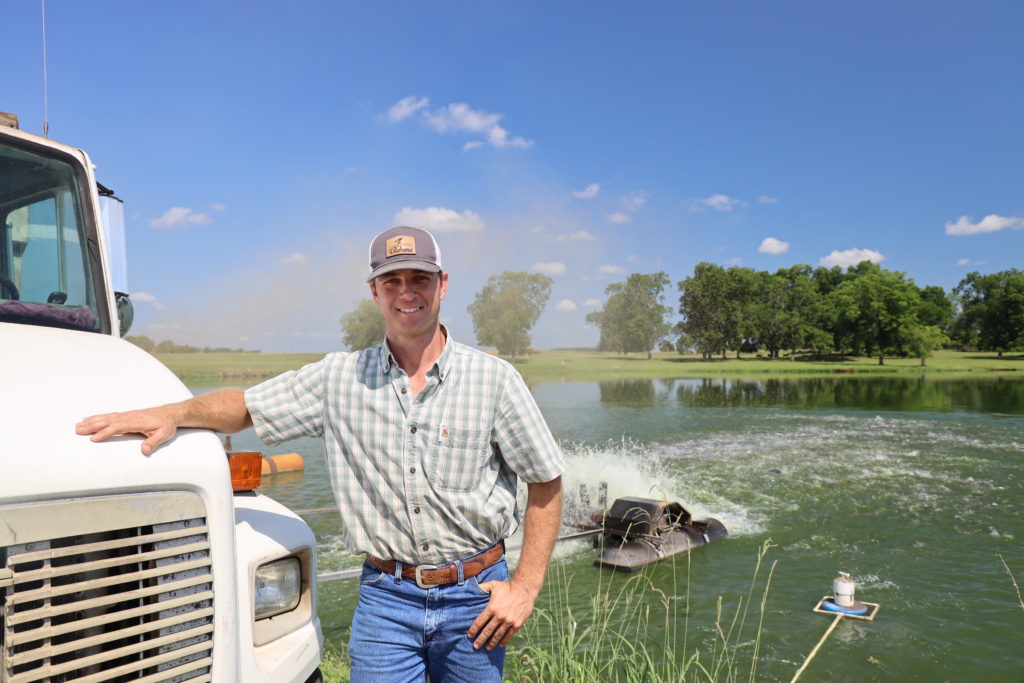Fingerling To Fillet: Get Hooked On Alabama Catfish

By Josie Chance
Three-year-old Kirk Dees snacked on crispy catfish as his grandparents, Sid and Susan Nelson, pulled another batch from the fryer.
“Regardless of how you cook catfish, it’s delicious,” Sid said. “No sauce needed.”
Kirk nodded in agreement as light from the kitchen window illuminated the towhead’s smile. Outside, the summer sun reflected off acres of water where his parents, Denzil and Alex, carry on a pond-to-plate tradition spanning four decades.
“You can’t just dig a hole and throw fish in it,” Sid said. “There’s an art to catfish farming.”
For the Nelson and Dees families, the recipe for a successful fish fry starts long before fillets and cornmeal enter the kitchen.
Established in 1912 when Sid’s grandfather relocated from Pennsylvania to Alabama, Penala Farms was originally a cattle and sheep operation. The Black Belt’s heavy clay soils, however, were ideal for holding water, and the farm’s proximity to Alabama and Mississippi processors made Sumter County the perfect spot to build the Nelsons’ first catfish pond in 1981.
Today, Sid and Denzil manage 20 catfish ponds covering more than 200 acres, along with a 250-300 head beef cattle herd. It’s a lifestyle that keeps the family busy year-round.
The production cycle starts with delivery of 4- to 6-inch catfish, called fingerlings, in late winter or early spring. The fish are fed for the next 13-15 months. As the fingerlings grow, Sid and Denzil watch to make sure oxygen levels stay above 3 parts per million (ppm). Aerators designed to help oxygen flow through the water turn on automatically if levels drop below 4 ppm.
Even with modern technology, Denzil said catfish farming is a hands-on, 24/7 job.
“Each pond is a little different,” he said. “One pond’s fish might eat fine, while another won’t eat at all that morning. We care for each pond individually.”
At feeding time, farmers fill trucks with pellets or flakes of dry feed made from cornmeal, soybean meal, cottonseed and other byproducts. They drive next to the ponds, dispensing the feed into the water using a blower. The water’s surface bubbles as fish gobble the floating feast.
Feeding fish is precise. Each pond has a specific spot where the fish are fed on a strict schedule. The amount of feed per day is closely monitored by scales or timed feedings. As water heats up and summer progresses, each pond’s fish can consume over a ton of feed per day. Denzil said farmers pay close attention to details and adjust accordingly to get the ideal 1.5- to 2-pound fish.
“Farmers often are the only ones to feed their own fish,” he said. “Every part of it is so particular, and no one wants to mess that up.”
Other fish, like shad, play a crucial role in creating an optimal water environment. They help reduce algae levels by feeding on microorganisms and leftover feed. This lessens the need to drain ponds.
Quality control is important, Denzil said. Farmers take a sample fish from each pond to the processor about three weeks before harvest. A taste test ensures consumers get mild, flavorful catfish.
Once a pond passes the test, producers prepare for harvest.
“Originally, we would drain the ponds entirely every harvest,” Sid said. “That made us more dependent on rainfall and our watershed to completely refill the ponds.”
Today, catfish farmers gather their crop in the spring through a process called seining. Boat crews pull nets across the pond from reels attached to tractors along the bank. As the net is tightened, fish are channeled into a narrow section called the sock. Fingerlings and shad slip back into the pond through holes in the netting, leaving only harvest-size fish.
Once the fish are contained, a boom hoists the sock to awaiting trucks. The fish are placed into tanks with chilled water and are transported live to the facility where, after another quality test, they are processed under U.S. Department of Agriculture inspection.
“Catfish are fresh,” Denzil said. “The entire harvest procedure happens within 24 hours to ensure consumers get the highest quality product.”
Flash-frozen fillets are loaded onto trucks and delivered in boxes labeled with the U.S. Farm-Raised Catfish logo to grocery stores, mom-and-pop shops and wholesale distributors.
While flaky, clean-tasting catfish are versatile and can be grilled, baked or pan-seared, frying is a sure-fire win for all taste buds, Sid said.
Back in the kitchen, Susan and Sid demonstrate their preferred preparation. Split fillets; dip in egg or buttermilk; and coat with seasoned cornmeal. For the perfect, crispy bite, cook the fillets a minute or two after the fish floats, Sid said.
“You can’t beat the taste,” he said. “With U.S. Farm-Raised Catfish, you know you’re getting a fresh, high-quality product every time.”
For more delicious catfish recipes, visit USCatfish.com.
